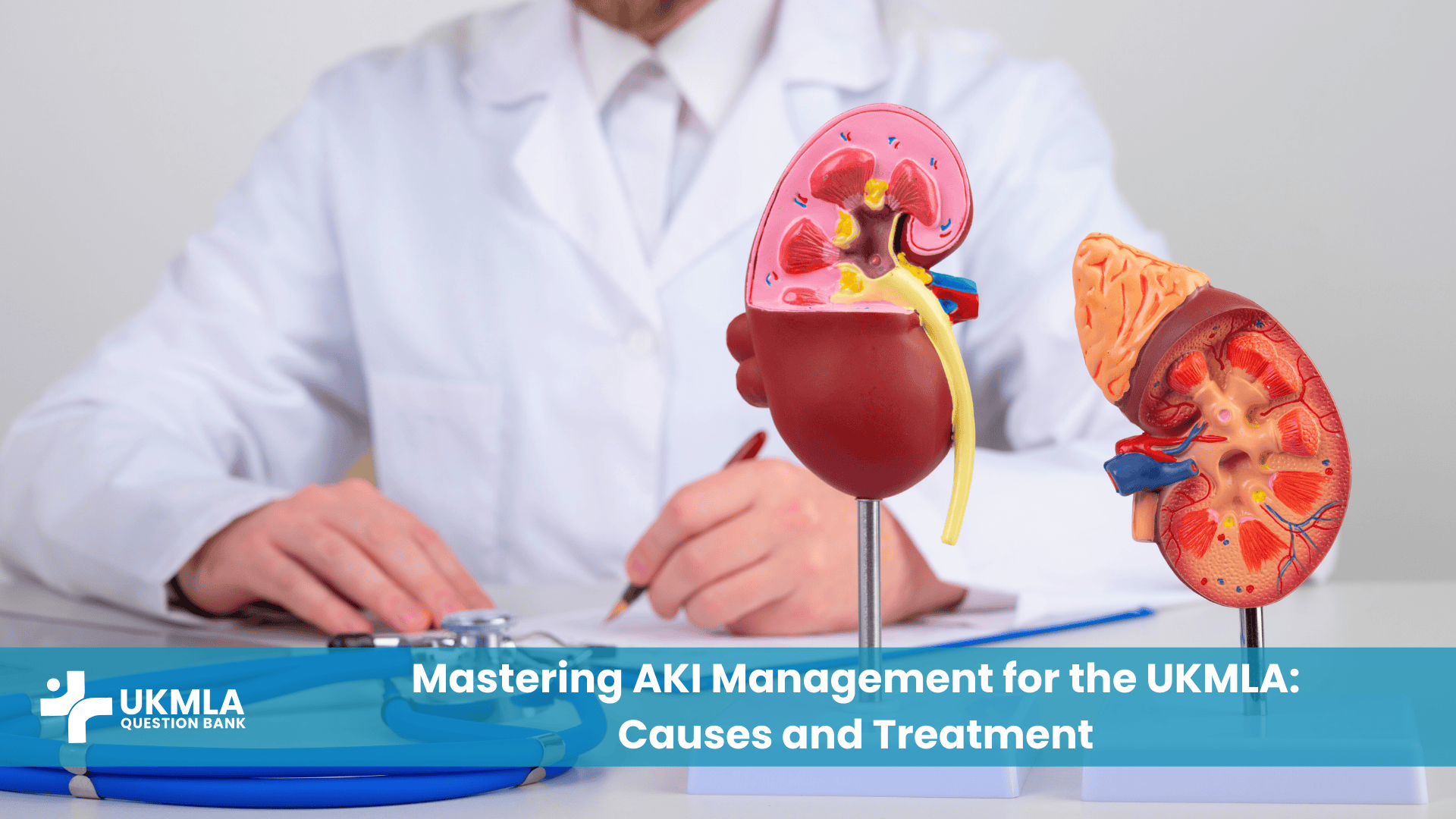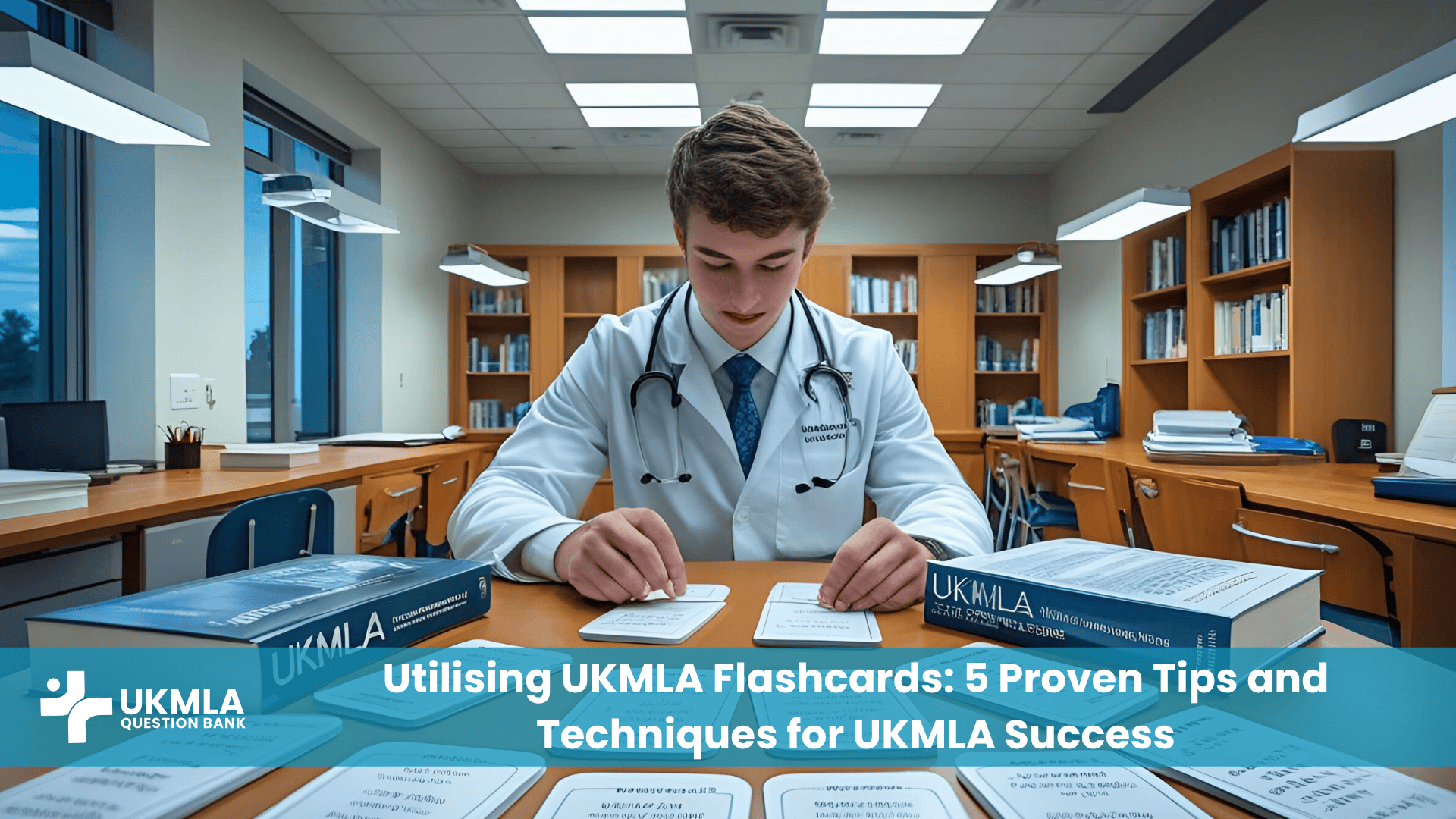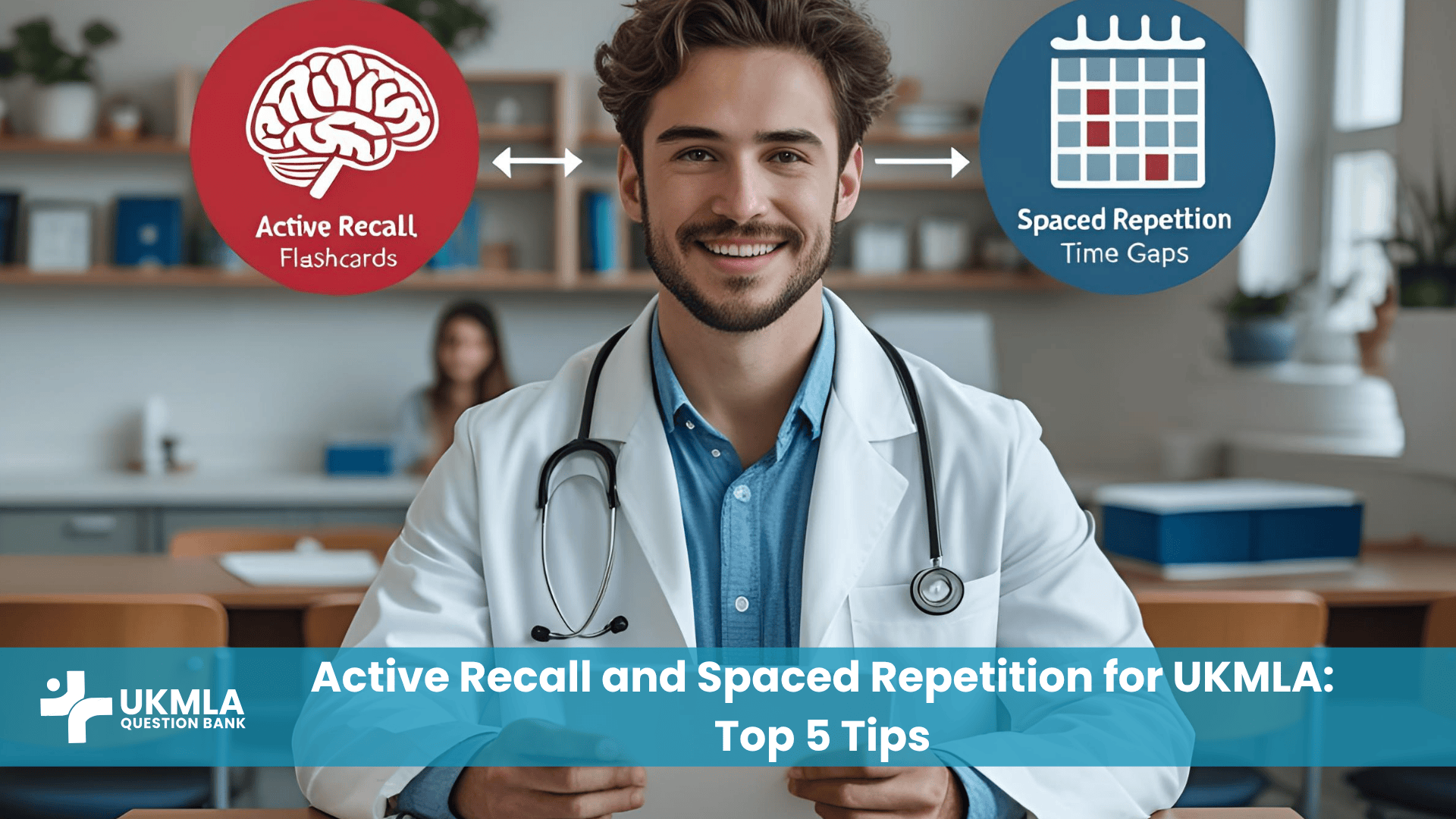Introduction
AKI management UKMLA is a core clinical topic that every candidate must master. Acute Kidney Injury (AKI) is not a rare phenomenon; it is a common and serious condition encountered daily in UK hospitals, affecting patients on nearly every ward. Its potential for rapid deterioration and significant morbidity and mortality makes it a high-yield subject for both the UKMLA AKT and CPSA. The exam will test your ability to apply a systematic approach to identify the cause, assess the severity, and initiate safe and timely management. This is a foundational topic in nephrology and urology for the UKMLA.
This guide provides a clear, 5-step framework to build your confidence in managing AKI, aligning with the definitive UK clinical guidance from NICE on Acute kidney injury. By internalizing this systematic process, you’ll be able to deconstruct complex clinical vignettes, make safe decisions under pressure, and demonstrate the competence expected of a foundation year doctor.
Table of Contents
ToggleAKI Management UKMLA: A 5-Step Proven Framework
Step 1: Diagnosis and Staging (Confirming the AKI)
Before you can manage AKI, you must first diagnose it. The diagnosis of AKI is based on biochemical markers, not clinical signs alone. The internationally recognized KDIGO (Kidney Disease: Improving Global Outcomes) criteria are used. You must be able to recognize AKI from a set of U&Es.
AKI is diagnosed if one or more of the following is present:
A rise in serum creatinine by ≥26.5 µmol/L within 48 hours.
A rise in serum creatinine to ≥1.5 times the baseline, which is known or presumed to have occurred within the prior 7 days.
A fall in urine output to <0.5 mL/kg/hour for 6 hours.
Once diagnosed, the severity is staged from 1 to 3 based on the degree of creatinine rise or urine output fall. Stage 3 is the most severe. Recognizing these trends is a key part of interpreting clinical data for the UKMLA AKT.
Step 2: Identifying the Cause (Pre-renal, Renal, or Post-renal)
Once you’ve confirmed AKI, the next crucial step is to determine the underlying cause. A helpful mental model is the “renal sieve,” which categorizes causes based on where the problem lies in relation to the kidney.
Table 1: The Renal Sieve – Common Causes of AKI
| Category | Mechanism | Common Causes |
|---|---|---|
| Pre-renal | Inadequate blood flow to the kidneys. | Hypovolemia (e.g., dehydration, haemorrhage), Sepsis, Cardiogenic shock, Hepatorenal syndrome. |
| Intrinsic Renal | Direct damage within the kidneys. | Acute Tubular Necrosis (ATN) from ischemia or nephrotoxins, Glomerulonephritis, Acute Interstitial Nephritis (AIN). |
| Post-renal | Obstruction of urine flow from the kidneys. | Benign prostatic hyperplasia (BPH), kidney stones, blocked urinary catheter, pelvic malignancy. |
Pre-renal AKI is the most common type, accounting for the majority of cases. The kidneys themselves are healthy, but they are not receiving enough blood to function properly. A classic example is a patient with diarrhoea and vomiting leading to dehydration, or a patient with sepsis where systemic vasodilation leads to relative hypovolemia and poor renal perfusion.
Intrinsic Renal AKI implies damage to the kidney tissue itself. This can be to the tubules (ATN, often following prolonged pre-renal insult), the glomeruli (glomerulonephritis), or the interstitial tissue (AIN, often an allergic reaction to drugs).
Post-renal AKI is a blockage. Urine is being produced but cannot drain, causing back-pressure that damages the kidneys. This is a crucial diagnosis to make as it is often easily reversible if the obstruction is relieved.
Step 3: Key Investigations
Your investigations are guided by your search for the cause.
Bedside: A fluid balance chart is essential. Urinalysis is a simple but powerful tool—the presence of blood and protein may suggest glomerulonephritis, while white cells and nitrites suggest a UTI that could be causing sepsis.
Bloods: A full set of bloods including U&Es (to monitor creatinine and potassium), FBC, and CRP is standard.
Imaging: A renal ultrasound is the single most important imaging modality. It is used to look for hydronephrosis, which indicates a post-renal obstructive cause.
Step 4: Core Management Principles
The management of AKI revolves around three core principles.
The NICE guidelines state: “Offer intravenous fluid resuscitation for adults with AKI… if they are hypovolaemic. Assess the patient’s fluid status and… give a fluid challenge of 250-500 ml of crystalloid over less than 15 minutes.”
Assess and Optimise Fluid Status: The first step is to carefully assess the patient’s fluid status (pulse, BP, JVP, capillary refill). If they are hypovolaemic (the cause of most pre-renal AKIs), a cautious IV fluid challenge should be given.
Stop Nephrotoxic Drugs: Many common drugs can worsen renal function. Review the patient’s medication chart and stop any nephrotoxic agents. A common mnemonic for this is DAMN:
Diuretics (can worsen pre-renal AKI if the patient is already dry)
ACE inhibitors / ARBs
Metformin
NSAIDs For more on this, review our guide to high-yield pharmacology for the UKMLA.
Treat the Underlying Cause: Your management must be tailored to the cause you identified in Step 2. This could mean giving antibiotics for sepsis, carefully starting diuretics for a cardiorenal cause, or inserting a urinary catheter for a post-renal obstruction.
Step 5: Manage Life-Threatening Complications
The most immediate life-threatening complication of severe AKI is hyperkalaemia, as it can cause fatal cardiac arrhythmias. If a patient’s potassium is dangerously high (typically >6.5 mmol/L or if there are ECG changes), you must initiate emergency management.
Table 2: Emergency Management of Hyperkalaemia
| Step | Intervention | Mechanism of Action |
|---|---|---|
| 1. Protect the Heart | Calcium Gluconate (10ml of 10% IV) | Stabilises the cardiac membrane to prevent arrhythmias. |
| 2. Shift Potassium into Cells | Insulin/Dextrose (e.g., 10 units Actrapid in 50ml 50% Dextrose) | Drives potassium from the blood into the intracellular space. |
| 3. Shift Potassium into Cells | Salbutamol Nebulisers | Also helps to shift potassium into cells. |
| 4. Remove Potassium | Calcium Resonium / Dialysis | Long-term solutions to actually remove potassium from the body. |
Frequently Asked Questions (FAQ) about AKI and the UKMLA
AKI is a sudden deterioration in kidney function over hours or days. CKD is a long-term condition where kidney function has been declining over at least 3 months. A patient with CKD can also develop an “AKI on CKD”.
AKI is staged from 1 to 3 based on the rise in creatinine from baseline or the drop in urine output. Stage 1 is a 1.5-1.9 times rise in creatinine, Stage 2 is 2.0-2.9 times, and Stage 3 is a 3 times rise or an increase to ≥354 µmol/L or initiation of renal replacement therapy.
Casts are cylindrical structures formed in the kidney tubules and found in the urine. Different types of casts can point to specific intrinsic renal diseases. For example, “muddy brown” granular casts are characteristic of Acute Tubular Necrosis (ATN).
Indications for referral include severe AKI (Stage 3), a suspected intrinsic renal disease (e.g., glomerulonephritis), complications that are difficult to manage (e.g., severe hyperkalaemia or acidosis), or if the cause of the AKI is unclear.
This is a specific type of pre-renal AKI that occurs in patients with advanced liver cirrhosis. The severe liver disease leads to complex changes in blood flow that cause the kidneys to fail, even though the kidneys themselves are structurally normal.
No. A renal biopsy is an invasive procedure and is typically only performed if the cause of the intrinsic AKI is unclear and a diagnosis of a condition like vasculitis or glomerulonephritis is suspected, as this would significantly alter management.
Metformin is cleared by the kidneys. In AKI, metformin can accumulate in the body, which carries a significant risk of causing a severe lactic acidosis, a life-threatening complication.
Yes, many patients, especially those with pre-renal or post-renal causes, can make a full recovery if the underlying cause is treated promptly. However, a severe episode of AKI is a major risk factor for developing CKD in the future.
In a CPSA station, you might be given a set of blood results showing a rising creatinine and high potassium. You would be expected to recognise the AKI and its complication, and articulate the immediate, safe management plan (A-E assessment, stop nephrotoxics, treat hyperkalaemia, investigate the cause).
Identifying the cause using the “pre-renal, renal, post-renal” sieve. The management is entirely dependent on the underlying aetiology, so a logical and thorough search for the cause is the most critical step.
Conclusion
Mastering AKI management UKMLA is about applying a structured and systematic approach to a common clinical problem. By following the 5-step framework—Diagnose and Stage, Identify the Cause, Investigate, Manage, and treat Complications—you can confidently navigate any AKI scenario presented in the UKMLA. This logical process prevents you from missing crucial steps and ensures your management plan is safe and effective.
Remember that this is not just about passing an exam; it is about developing the skills to manage a sick patient safely. The principles of Good medical practice require you to be competent and to work within your limits. A systematic approach to conditions like AKI is a cornerstone of that competence.




